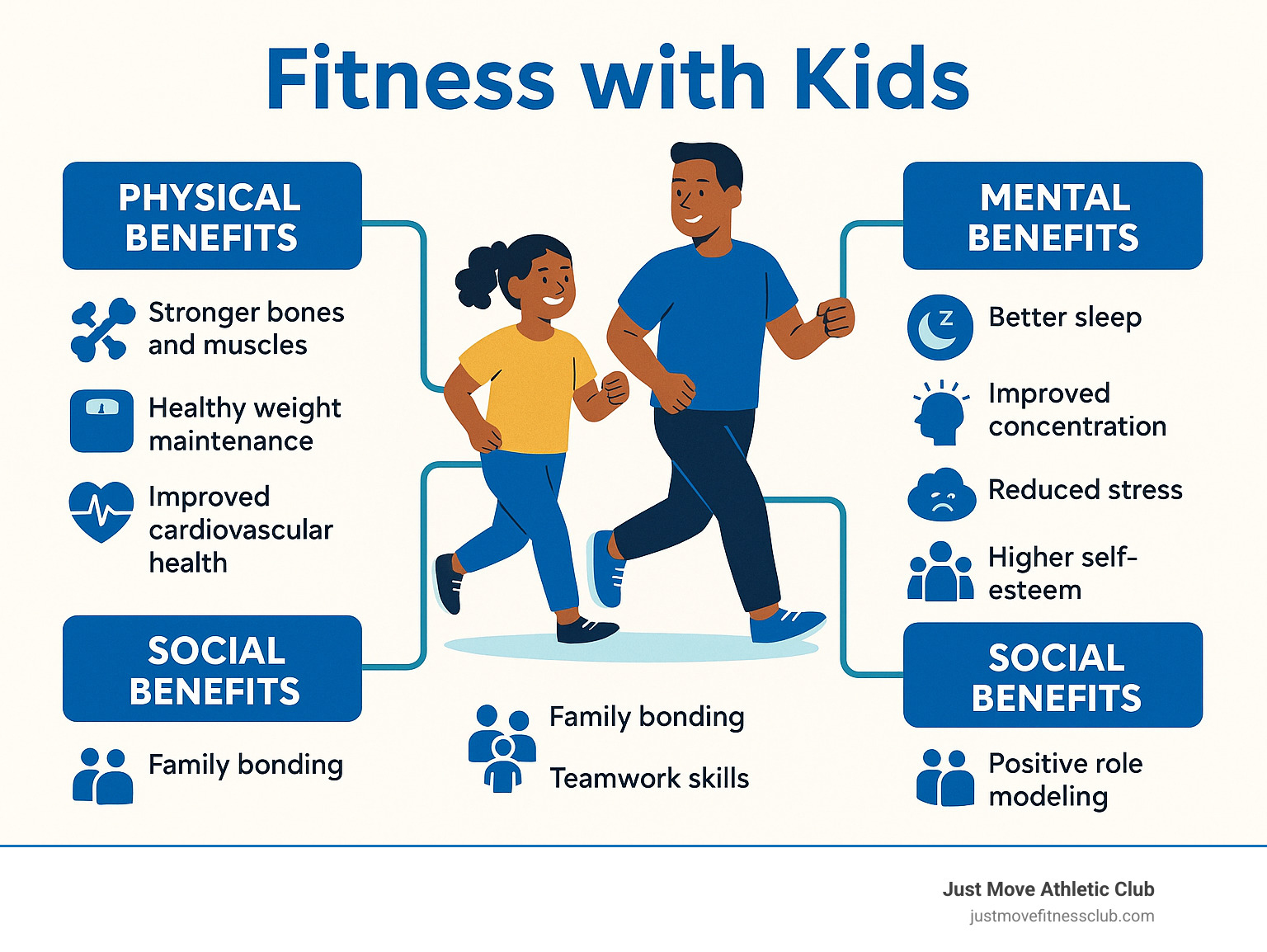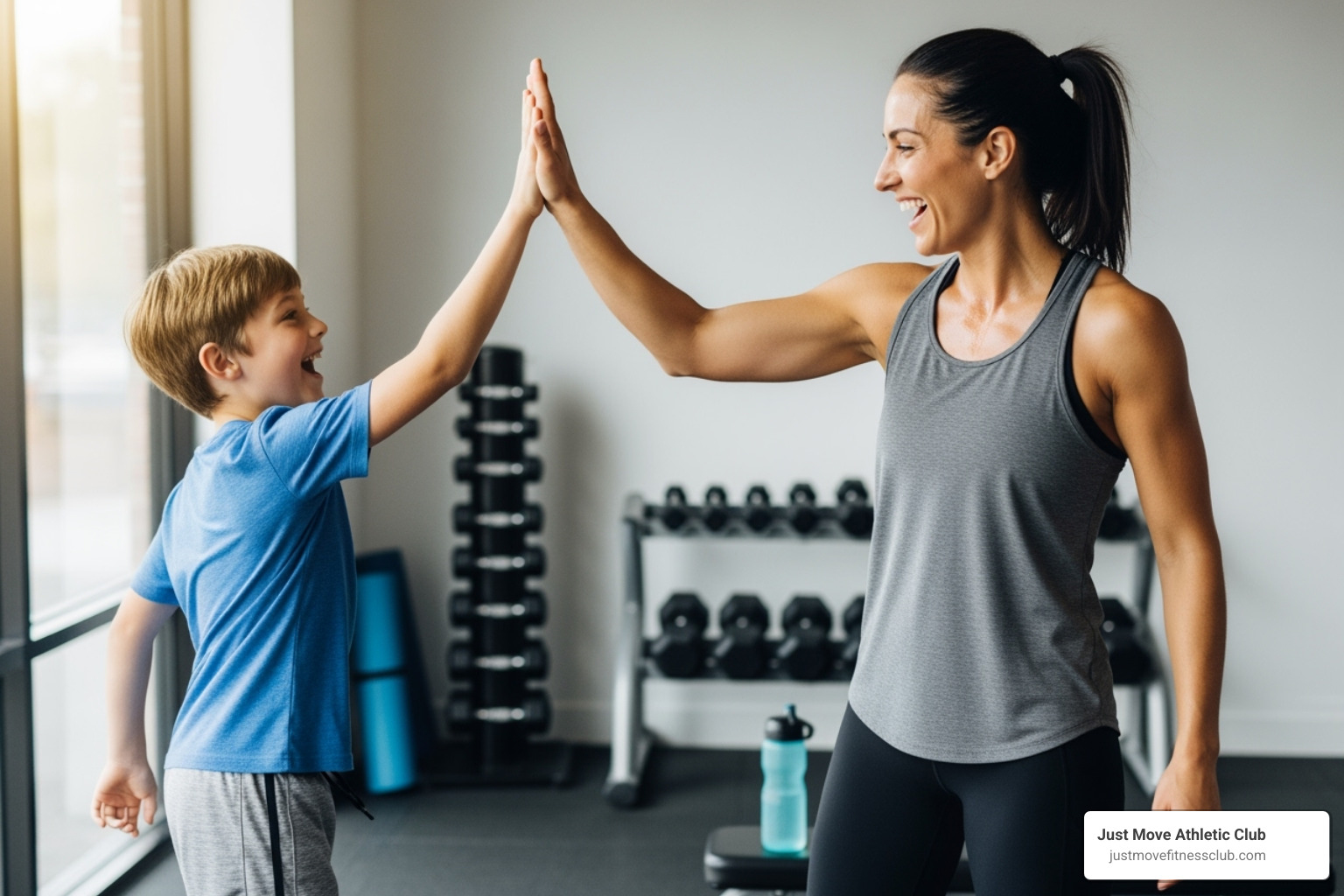Why Your Family Needs to Move Beyond the Screen
Fitness with kids is the solution to a growing problem in American homes. Here’s what you need to know:
Essential Guidelines for Family Fitness:
- Preschoolers (2-5): 3 hours of active play daily
- School-age kids (6-17): 60+ minutes of moderate-to-vigorous activity daily
- Focus: Make it fun, not forced
- Start small: Even 10-15 minutes makes a difference
- Include variety: Cardio, strength, and flexibility activities
The numbers are stark: Less than a third of children meet the recommended 60 minutes of daily activity, earning American kids a D-minus on the U.S. Report Card on Physical Activity. Meanwhile, parents with young children often get less exercise than those without.
The good news? When kids are active with a parent, they’re far more likely to be active on their own. Family fitness builds stronger bodies, better moods, improved sleep, and lifelong healthy habits.
This guide will show you practical ways to get your whole family moving. You’ll find age-appropriate activities, overcome common obstacles, and learn how to make exercise the highlight of your family’s day.
I’m Pleasant Lewis JMAC, founder of Just Move Athletic Clubs. With over 40 years in the fitness industry, I’ve seen how fitness with kids creates stronger families and lifelong wellness. My approach is to create welcoming spaces where families feel empowered on their health journeys together.

Why Family Fitness Matters: More Than Just Movement
When you explore fitness with kids, you realize it’s about more than just getting sweaty. The physical benefits are incredible, but the ripple effects touch every corner of your child’s development and your family’s happiness. Every time your family moves together, you’re investing in your child’s future health, emotional resilience, and your relationship.
Physical Health
Let’s start with what exercise does for a growing body. The benefits are amazing.
- Stronger bones and muscles develop from weight-bearing activities like running, jumping, and climbing. These fun activities build the foundation for a healthy adulthood.
- Healthy weight management becomes natural when kids are regularly active. When it’s fun family time, kids don’t even realize they’re working on maintaining a healthy weight.
- Muscle development during childhood sets the stage for lifelong strength and mobility, improving coordination, balance, and overall physical competence.
According to the CDC’s research on physical activity benefits for children, regular activity also improves cardiovascular health, leading to lower blood pressure and reduced risk of developing conditions like type 2 diabetes.
Mental & Emotional Wellbeing
The mental and emotional benefits of fitness with kids often surprise parents the most.
- Better sleep is often the first thing parents notice. Active kids fall asleep faster and sleep more soundly.
- Improved concentration shows up at home and in school. Research shows that kids who move more perform better academically.
- Reduced stress is crucial for kids, too. Exercise is a natural stress reliever and mood booster, helping children work through anxiety and decreasing the likelihood of depression.
- Higher self-esteem builds as kids master new physical skills, creating confidence that carries over into other areas of life.
Family Bonding
This is where the magic happens. Fitness with kids creates dedicated, distraction-free family time.
- Quality time becomes automatic when you’re hiking or playing an active game. Moving together breaks down barriers and gets everyone talking.
- Shared goals, like training for a fun run or committing to a daily walk, create teamwork and a sense of collective accomplishment.
- Positive role modeling happens naturally when kids see parents prioritizing health. When you’re active with your child, they are far more likely to stay active on their own.

The beautiful thing about family fitness is that it doesn’t require perfection. It just requires showing up, moving together, and having fun. The benefits—stronger bodies, happier minds, and closer family bonds—will follow.
Age-Appropriate Fitness: From Toddler Tumbles to Teen Training
Matching activities to your child’s developmental stage is the secret to successful fitness with kids. A toddler’s idea of exercise is completely different from a teen’s, and that’s okay!
| Age Group | Recommended Daily Activity | Types of Activities | Screen Time Limits |
|---|---|---|---|
| Toddlers/Preschoolers (2-5) | 3 hours of active play throughout the day | Unstructured play, fundamental movements, animal walks, dancing | 1 hour or less for ages 2-5 |
| School-Aged Kids (6-12) | 60+ minutes moderate-to-vigorous activity | Organized sports, bike riding, playground workouts, bodyweight exercises | No more than 2 hours inactive at a time |
| Teens (13-17) | 60+ minutes moderate-to-vigorous activity, including muscle/bone strengthening 3x/week | Structured workouts, individual/team sports, strength training, HIIT, yoga | Individual family guidelines |
Toddlers & Preschoolers (Ages 2-5): The Power of Play
For little ones, fitness is all about play. The goal is 3 hours of active play throughout the day, which includes everything from running in the yard to dancing in the living room. Focus on unstructured play like hide-and-seek or playground adventures. This is the time to build fundamental movements like running, jumping, and climbing. Animal walks (bear crawls, bunny hops) and dancing are perfect ways to get moving together. You can also try fun yoga videos for kids that mix movement with imagination. The American Academy of Pediatrics recommends limiting screen time to one hour daily for this age group. For more guidance, check out this expert advice on kids and exercise.
School-Aged Kids (Ages 6-12): Building Skills and Habits
As kids enter school, their coordination and attention spans grow. They need 60+ minutes of moderate-to-vigorous activity daily, including muscle and bone-strengthening activities three times a week. This is a great time for skill development through organized activities like swimming or martial arts, but team sports aren’t required to be healthy. Family bike rides and swimming are fantastic full-body workouts. Your local park offers great playground workouts where kids naturally climb and swing. You can also gamify bodyweight exercises like push-ups, squats, and planks to make them fun challenges.
Teenagers (Ages 13-17): Fostering Independence and Strength
Teens are developing their own identities, and their fitness should reflect that. They still need 60+ minutes of daily activity but can handle more sophisticated exercise. Structured workouts, individual sports (running, tennis), and team sports are all great options. It’s a myth that strength training stunts growth; research on safe weight lifting for teens shows it’s incredibly beneficial with proper form and supervision. HIIT workouts are efficient for busy schedules, and yoga builds flexibility and mental focus. The key is giving teens choices to help them find activities they genuinely enjoy, setting them up for a lifetime of healthy movement.
Making Movement Irresistible: Fun Games and Creative Workouts
The magic of successful fitness with kids is making it so fun, they forget they’re exercising. The secret is gamification: turn any activity into an adventure with storylines or challenges. Instead of running laps, you’re racing to save the world!
Themed workouts tap into your child’s imagination. A “Dino Findy” workout could involve stomping like a T-Rex and stretching like a Brontosaurus. Most importantly, let your kids choose what sounds fun. When they have ownership, their enthusiasm skyrockets.

Creative Indoor Fitness with Kids
Rainy days don’t have to stop the fun. Your living room can be an amazing activity center!
- Obstacle courses: Use couch cushions for balance beams and chairs to crawl under. It’s a fun challenge you can adjust for any age.
- Dance party: Crank up their favorite songs and let loose! Try “freeze dance” for extra giggles.
- Active video games: Games like “Just Dance” combine technology with cardio in a way that feels natural to kids.
- Balloon volleyball: The goal is simple: keep the balloon from touching the floor. It’s surprisingly active and great for small spaces.
- “The Floor is Lava”: A timeless classic that gets kids leaping from couch to chair, working on balance and coordination.
- Yoga for children: Fun yoga videos for kids use storytelling and animal poses that feel like imaginative play.
Awesome Outdoor Adventures
Getting outside multiplies the possibilities for family fitness.
- Hiking and scavenger hunts: Explore local parks and nature trails. Turn your hike into a scavenger hunt by challenging kids to find specific items like pinecones or smooth rocks.
- Family bike rides: Build endurance while exploring new neighborhoods or bike trails. Even toddlers can join in trailers.
- Backyard sports: Set up a game of soccer, kickball, or tag. Simple games can provide an intense cardio workout for everyone.
- Playground challenges: Turn equipment into a fitness circuit. Time each other crossing the monkey bars or running the perimeter.
- Tag variations: Keep things fresh with “freeze tag” or “shadow tag” to get the whole family running and laughing.
The key is remembering that fitness with kids should feel like play. When movement is associated with joy and family time, you’re building lifelong healthy habits.
Overcoming Problems: Practical Tips for Fitness with Kids
Incorporating fitness with kids into a packed family life can feel overwhelming. Parents with young children often get less exercise, but with a few smart strategies and a shift in perspective, you can make family fitness work.

Fitting Fitness into a Packed Schedule
Time is a huge challenge. The key is to think differently about how exercise happens.
- Schedule it: Block out time for family movement in your calendar. Treat it as non-negotiable family time.
- Use “exercise snacks”: Short 10-15 minute bursts of activity add up. Try squats while coffee brews or a dance party while dinner cooks.
- Make daily tasks active: Walk or bike to school. Take the stairs. Park farther from store entrances to integrate movement into your routine.
- Make weekends adventure time: Dedicate weekend mornings to longer activities like hiking or exploring new parks.
- Use the “I go, you go” method: One parent exercises while the other supervises the kids, then switch.
Motivating a Child Who Dislikes Sports
Not every child loves traditional sports, and that’s okay. The goal is to help your child find joy in being active, not to create an Olympian.
- Focus on fun, not competition: Emphasize play and personal enjoyment. Celebrate effort over results.
- Explore individual activities: Many kids thrive with activities like martial arts, gymnastics, or dancing, which build confidence and skill without team pressure.
- Find the reason for resistance: Gently ask why your child dislikes sports. Understanding their concerns helps you find better alternatives.
- Practice at home: If a child is nervous to try something new, practice basic skills in a low-pressure environment first.
Your attitude makes all the difference. For more strategies, this resource offers helpful insights: Helping kids who don’t like sports.
Using Technology for Good
While we worry about screen time (the American Academy of Pediatrics recommends limiting it to 1 hour daily for ages 2-5), technology can be an ally for fitness with kids.
- Fitness apps: Many apps offer kid-friendly workouts or challenges that turn exercise into a game.
- Geocaching: This modern treasure hunt uses GPS to lead your family on walking adventures to find hidden containers.
- Activity trackers: For older kids, counting steps can be motivating. Set family challenges to make it a team effort.
- Active video games (exergaming): Games like “Just Dance” provide genuine workouts, especially on bad weather days.
The key is using technology to improve real-world activity, not replace it.
Frequently Asked Questions about Family Fitness
As parents start their journey with fitness with kids, a few common questions always come up. Here are the answers to the most frequent ones.
How much exercise do kids really need?
The amount depends on your child’s age but is very achievable. Preschoolers (2-5) need about 3 hours of active play throughout the day. This isn’t structured exercise, just active time.
School-aged kids and teens (6-17) need 60 minutes or more of moderate to vigorous activity daily, including muscle and bone-strengthening activities three times a week. Consistency matters more than intensity, especially when you’re starting out.
Is it safe for my child to lift weights?
Yes, it is absolutely safe for children to lift weights with proper supervision and form. The myth that it stunts growth has been thoroughly debunked by research; in fact, strength training is very beneficial for kids and teens.
Supervision is key. Always start with light weights and focus on technique. For younger children, bodyweight exercises like push-ups and squats are perfect. As they get older, they can gradually add resistance. The goal is always safe movement patterns and building strength confidently.
What are the best ways to start if we’re an inactive family?
If your family is new to being active, the secret is to start small and build momentum.
- Family walks are a perfect start. They’re free and simple. Begin with 10-15 minutes after dinner and let your kids set the pace.
- Choose one fun activity per week that everyone agrees on. Letting kids pick—whether it’s the playground or a backyard game—boosts their enthusiasm.
- Focus on consistency and fun. If everyone is laughing, you’re doing it right. The goal is to build healthy habits that last a lifetime, not to become fitness fanatics overnight.
Conclusion: Building a Foundation for a Healthy, Active Life
Fitness with kids is about more than just movement; it’s about building memories, strengthening relationships, and creating the foundation for a lifetime of healthy choices. Every shared activity is an investment in your child’s future well-being.
The beauty of family fitness is its simplicity. You don’t need expensive equipment or a gym membership. You just need to start where you are, with what you have. Consistency trumps perfection every time.
When your children see you choosing activity over screens and experience the joy of accomplishing a physical challenge together, they learn that exercise can be fun. You’re not just improving their current health; you’re shaping their relationship with fitness for decades to come.
The challenges of packed schedules or reluctant kids are real, but there’s always a solution. The key is flexibility and keeping the focus on fun and connection.
At Just Move Athletic Club in Lakeland and Winter Haven, we help families find the joy of moving together. We offer custom fitness experiences, from group classes to personal training, that fit your family’s unique needs and goals.
We love seeing families support each other’s progress. While our Fit3D Pro Body Scanner helps track improvements, the real victories are the daily healthy choices and shared accomplishments that make exercise a highlight of your day.
Your family’s fitness journey doesn’t have to be perfect. It just has to be yours. Start small, stay consistent, and celebrate every step forward. Whether you’re chasing toddlers or strength training with your teenager, you’re building something beautiful together.
Ready to take the next step? We’d love to welcome your family into our community. Start your family’s fitness journey with us and let’s create something amazing together.
